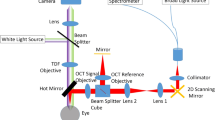Background: As the slit-lamp technique is an restrictive method for the in-vivo examination and documentation of the multi-layer structure and the dynamics of the tear film and the cornea, e. g. during wound-healing processes, our aim was to find out whether it is possible to change the confocal laser scanning ophthalmoscope (CLSO; Zeiss) into a high-resolution confocal laser scanning microscope (CLSM) for the visualization of the anterior segments of the eye and the tear film by adapting a special objective system. In order to gain information concerning the function of such a cornea microscope we examined selected patients with erosion or pterygium before and after operation and subsequent phototherapeutic keratectomy (PTK), as well as some in-vitro corneal surfaces after photorefractive keratectomy (PRK).
Material and methods: We developed an objective adapter for the CLSO in order to focus the laser beam onto anterior segments of the eye to visualize the tear film and the layer structure of the cornea. By combining the long-distance objective or a contact objective with different zoom-optic lenses it was possible to alter the scan field size and so the magnification of the CLSM by a factor of up to 1000.
Results: The CLSM provides a new method for the in-vivo examination of the tear film and its dynamics as well as the thin layers of the cornea in real-time imaging technique with high contrast and resolution in non-contact or contact procedures.
Conclusion: This system is a unique tool for evaluating and monitoring the effect of excimer laser ablation after PTK and PRK on the corneal surface and the dynamics of the tear film. The application of this method causes no pain for the patient.
Fragestellung: Für In-vivo-Untersuchungen des Tränenfilms mit seiner Dynamik und Schichtstruktur oder eines Wundheilungsprozesses an der Kornea mit einer aussagefähigen Bilddokumentation ist das Spaltlampenbiomikroskop nur bedingt geeignet. Es sollte daher untersucht werden, ob das konfokale Laser-Scanning-Ophthalmoskop CLSO (Zeiss) durch einen Objektivadapter in ein konfokales Laser-Scanning-Mikroskop CLSM für die vorderen Augenabschnitte und den Tränenfilm umgewandelt werden kann. Um Aussagen über die Funktionstüchtigkeit eines solchen Laserrasterbiomikroskops zu erhalten, untersuchten wir ausgewählte Patienten mit einer Erosion der Kornea nach einer Pterygiumoperation mit nachfolgender phototherapeutischer Keratektomie (PTK) sowie In-vitro-Korneae nach einer photorefraktiven Keratektomie (PRK) bzw. nach unterschiedlicher Tiefenablation mittels eines Excimerlasers.
Material und Methode: Für das CLSO wurde ein Objektivadapter als Vorsatzsystem entwickelt, durch den der Argonlaserstrahl auf die vorderen Augenabschnitte mit dem Tränenfilm und der Kornea zu deren Abbildung fokussiert werden kann. Durch Kombination eines langbrennweitigen Objektivs bzw. Immersionsobjektivs mit einer kleinen Zoomoptik können die Rasterfeldgröße auf der Kornea im Nonkontakt- bzw. Kontaktverfahren variiert und damit die Gesamtvergrößerung in einem Bereich bis zu 1000-fach verändert werden.
Ergebnis: Mit dem kofokalen Laser-Scanning-Mikroskop CLSM gelingt eine kontrastreiche und hochauflösende konfokale Untersuchung sowohl des Tränenfilms mit seiner Dynamik als auch von Strukturen dünnster Schichten in der Kornea im Echtzeitnonkontakt- oder -kontaktverfahren.
Schlußfolgerung: Das CLSM ist besonders gut geeignet für die Bewertung und Darstellung der Wirkung einer Excimerlaserablation auf der Kornea und die Struktur und Dynamik des Tränenfilms nach einer PTK oder PRK. Das Untersuchungsverfahren ist für den Patienten wenig belastend.
Similar content being viewed by others
Author information
Authors and Affiliations
Rights and permissions
About this article
Cite this article
Stave, J., Guthoff, R. First results of in-vivo visualization of the tear film and structures of the cornea with a modified confocal laser scanning ophthalmoscope. Ophthalmologe 95, 104–109 (1998). https://doi.org/10.1007/s003470050245
Issue Date:
DOI: https://doi.org/10.1007/s003470050245




